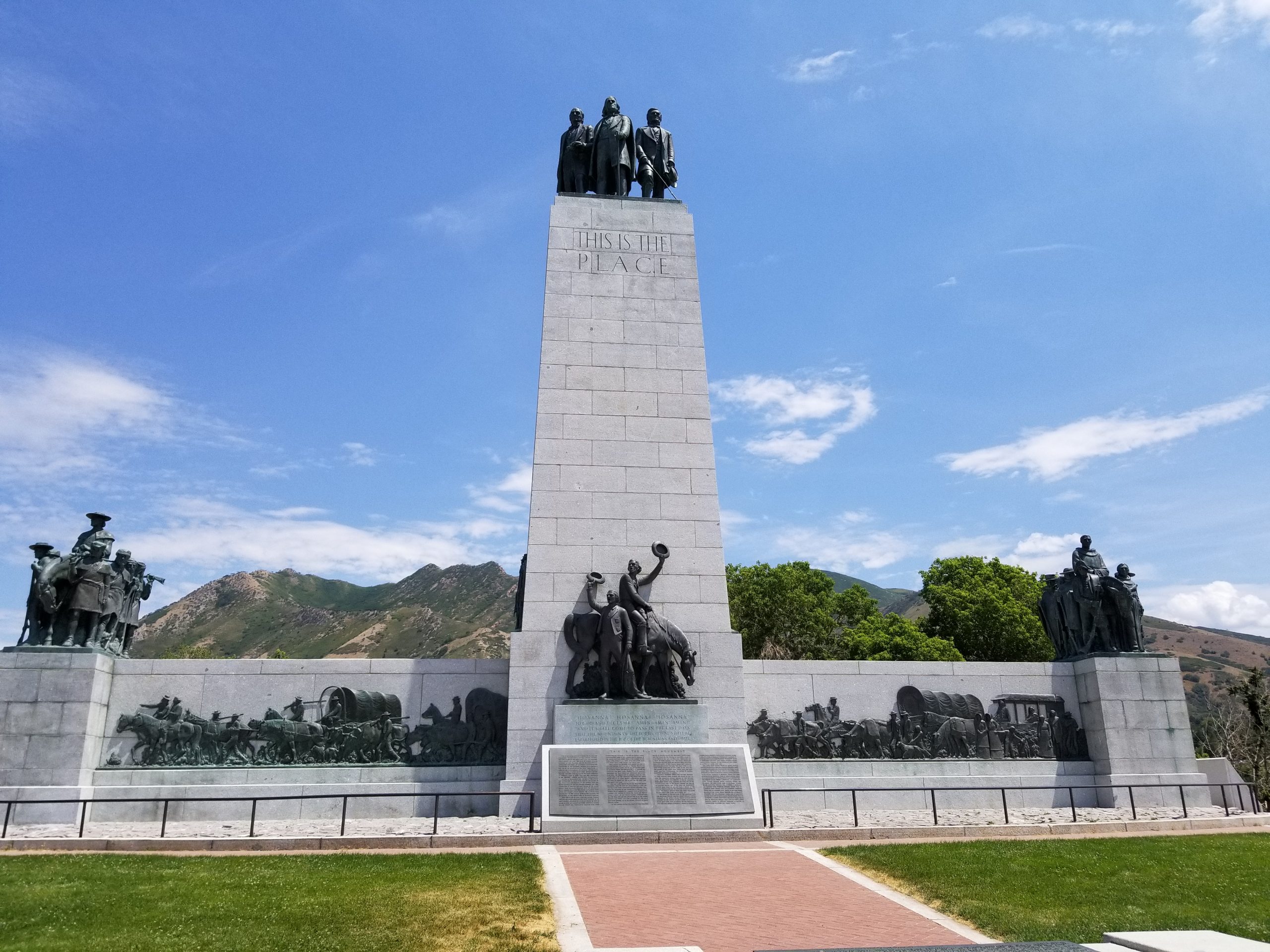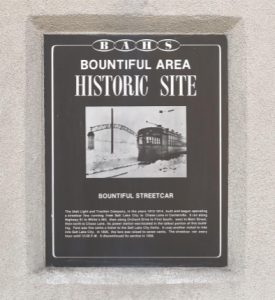Write-up by Christopher Bird
Placed by: Bountiful Area Historical Society
GPS Coordinates: 40°53`4“ N 111°52`20“ W
Historical Marker Text:
The Utah Light and Traction Company, in the years 1913-1914, built and began operating a streetcar line running from Salt Lake City to Chase Lane in Centerville. It ran along Highway 91 to White’s Hill, then along Orchard Drive to First South, west to Main Street, then north to Chase Lane. Its power station was located in the tallest portion of this building. Fare was five cents a ticket to the Salt Lake City limits. It cost another nickel to ride into Salt Lake City. In 1920, the fare was raised to seven cents. The streetcar ran every hour until 12:00 P.M. It discontinued its service in 1926.
Extended Research:
It took seventeen years between 1872 and 1889 for Salt Lake City to evolve from horse-drawn to electric street car service. However, following the first successful test of electric service in Richmond, Virginia, the electric car traveled quickly to Salt Lake, and began service there in August 1889.[1] Yet, it would then take another twenty-four years before a streetcar line opened in Davis County, North of Salt Lake City. When it did, the line ran from Centerville all the way into Salt Lake, a distance of merely 15 miles. Bountiful streetcar service started on 27 December 1913, with eighteen trolley trips per day and service until midnight (contrary to the Bountiful Area Marker which incorrectly states that service ended at 12 P.M. or noontime).[2]
In 1988, one rider, Ves Harrison, recalled the streetcar route this way:
As I remember, the line ran up Salt Lake City’s Main Street to North Temple turned west to old First West, then continued north to Beck Street, past the old St. Mark’s Hospital, thence north into Davis County on the old State Highway to North Salt Lake, where it veered onto Orchard Drive. It continued north to First South in Bountiful, then down Main Street and on to Centerville and its terminus at Chase Lane.[3]
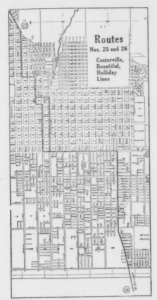
Routes Nos. 25 and 26 Centerville, Bountiful, and Holliday Lines, p. 33, Utah Light and Traction Company, 1921.
Mr. Harrison’s account is fairly accurate when compared against records from Utah Light and Traction Company, which operated the streetcar service in Davis County. A route booklet from 1921 describes both the north and south bound rail lines, whereas Harrison’s account only described riding the trolley car north. In 1921, the line to Bountiful was known as Route No. 25 and ran with Route No. 26 all the way from Centerville in Davis County to Holliday in Salt Lake County. The southbound route ran on Second South to Main Street then down to Ninth South, further proceeding to Holliday. The northbound route ran up State Street to First South then to West Temple and further proceeding to the Chase Lane Terminus in Davis County.[4] Harrison’s testimony further specified the streetcar line within Bountiful ran along Orchard Drive which matches the fact that the power station for the electric line was also located on Orchard Drive, the current location of the historical marker.
Although fares are described in the historical marker as costing a nickel, a contemporary newspaper accounts stated, “The Fare is as follows: From Bountiful to Salt Lake 15c, round trip 30c; with $2 commutation book 12c one way and 24c round trip; students 9c one way, 18c return.” All prices rose by a third for trips from Centerville at the opening of the trolley line.[5] Costs fell by 1921 when The Utah Light and Traction Company advertised, “It costs approximately 20 cents per mile to own and operate an automobile. It costs about 1 cent per mile to ride a street car. You can take a family of 10 for an outing on the street cars for one-half the cost to run an automobile. Be wise and economize.”[6] Further the company stated that a streetcar ride averaged four cents in 1916.[7]
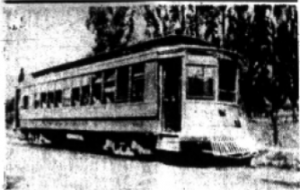
The Bountiful Streetcar: notice the cattle guard that boys infamously clung to in order to dodge fares. Courtesy of Davis County Clipper, Utah Digital Newspapers, J Willard Marriott Library.
Although a relatively cheap public service (a round trip service to Salt Lake in 1913 originally cost $6.27 in today’s dollars), certain groups committed hijinks attempting to ride for free. The Davis County Clipper recalls a particular anecdote with school boys. Young boys in Bountiful attempted to skate around the fare entirely by having one boy hail the streetcar at a stop and get on to pay, while his friends would latch onto the cowcatcher unseen and thus hitch a ride to wherever they needed to go for the price of one fare.[8] Companies dealt with more headaches than just schoolboys looking to hitch a free ride though. As streetcar and trolley companies consolidated, transfer privileges became necessary. Typically, conductors stamped transfer tickets with the date, time, and direction to prevent use on a return trip. Salt Lake trolley companies moved in a much more artistic direction. Instead of having a date or time to punch, transfer tickets of the Salt Lake transportation companies came with the faces of five different men, progressing from clean-shaven to what was described then as “House of David” for those who were quite lush with hair, as well as two variants for female riders, although the significant difference was between a young girl wearing a sailor hat and an older woman wearing a sort of bonnet. Conductors then punched out the closest match to the rider. No longer could young men with mutton chops run to the barbershop and come out clean shaven for the ride home, his ticket had already been punched! Despite this supposedly foolproof plan to prevent multiple riders using the same ticket, pushback from older women who resented their selection as “older” and dismal enforcement of slips forced the abandonment of transfer tickets.[9]
Cheap travel costs for riding the streetcar were unfortunately not enough. Ultimately, the demise of streetcars in Bountiful came because of the rise of rear-engine bus service. A short-article highlighting the features of an “automobile street car” appeared in the Davis County Clipper in mid-1921. The article touted the bus’s thirty-five passenger capacity, similar to that of a contemporary streetcar, as well as its most remarkable feature, a “‘gasoline-driven’ interurban car.”[10] Besides competitions from buses, private automobiles became affordable commodities for average-income citizens creating an increased demand for paved roads–roads that would have to be built over existing trolley lines across Salt Lake County and adjacent counties.[11] The rival Bamberger train route, which ran from Salt Lake City to Ogden, also increased competition for passenger fares. The Utah Light and Traction Company formally petitioned to close the line from the northern boundary of Salt Lake City on 27 January, 1926. The petition came after the Bamberger Electric Railroad Company petitioned for a bus-line between Salt Lake and Ogden that ran almost parallel to the streetcar route, apparently never deviating more than a quarter-mile from one another. The petition reported that income received from
the streetcar line to Davis County was far under the cost of operation and that the Utah Light and Traction Company needed to pay for twenty-thousand dollars (just over $287,000 today) to maintain the trolley-line, money that the company did not have.[12] Streetcar service thus ended in Bountiful in 1926 and almost fifteen years later Salt Lake’s last trolley ran the tracks on May 31, 1941.[13]
Ultimately, the advent of buses, private automobiles, and competition between transportation companies led to the demise of streetcar service in Bountiful and eventually Salt Lake County itself. Today, the building where the Bountiful route’s power station was located is at 480 South Orchard Drive. The only reference that there ever was a streetcar line operating from the building is a small marker on the building’s eastern facade. The building now houses a dental office and other small businesses, with the historical marker as the sole reminder of a time when electric trolley companies dominated public transportation and automobiles were a luxury only the wealthy could afford.
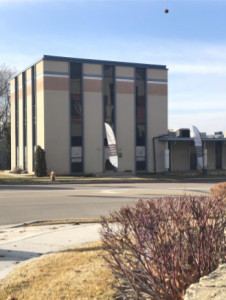
The building that housed the powerstation today. Located at 480 S. Orchard Drive in Bountiful. The Bountiful Area Historical Society Marker is seen just to the right of the planted flag. Photograph by Christopher Bird, January 25, 2020.
[1] C.W. McCullough, “The Passing of the Streetcar,” Utah Historical Quarterly 24, no. 2 (1956): 124, www.jstor.org/stable/45058629.
[2] “Street Car Will Start Running December 27,” Davis County Clipper, December 26, 1913, https://newspapers.lib.utah.edu/details?id=1165079&date_tdt=%5B1913-01-01T00%3A00%3A00.000Z+TO+1915-01-01T00%3A00%3A00.000Z%5D&q=%28%28Streetcar%29+AND+paper_t%3A%28Davis+AND+County+AND+Clipper%29%29.
[3] Doneta Gatherum, “Old memories flare as trolley car line celebrates 100 yrs,” Davis County Clipper, August 23rd, 1989, https://newspapers.lib.utah.edu/details?id=22522831&q=Bountiful+Streetcar&sort=rel.
[4] “Routes Nos. 25 and 26 Centerville, Bountiful, and Holliday Lines,” in Routes and Schedules of the Salt Lake City Street Car Lines, 32, Utah Light and Traction Company, 1921, https://utahrails.net/pdf/Utah-Light-Traction_Route-Booklet_circa-1921.pdf.
[5] “Street Car Will Start Running December 27,” Davis County Clipper, December 26, 1913, https://newspapers.lib.utah.edu/details?id=1165079&date_tdt=%5B1913-01-01T00%3A00%3A00.000Z+TO+1915-01-01T00%3A00%3A00.000Z%5D&q=%28%28Streetcar%29+AND+paper_t%3A%28Davis+AND+County+AND+Clipper%29%29.
[6] “Routes Nos. 25 and 26 Centerville, Bountiful, and Holliday Lines,” in Routes and Schedules of the Salt Lake City Street Car Lines, 32, Utah Light and Traction Company, 1921, https://utahrails.net/pdf/Utah-Light-Traction_Route-Booklet_circa-1921.pdf.
[7] “Routes No. 24 Depot Loop Lines,” in Routes and Schedules of the Salt Lake City Street Car Lines, 30, Utah Light and Traction Company, 1921, https://utahrails.net/pdf/Utah-Light-Traction_Route-Booklet_circa-1921.pdf.
[8] Doneta Gatherum, “Old memories flare as trolley car line celebrates 100 yrs,” Davis County Clipper, August 23rd, 1989, https://newspapers.lib.utah.edu/details?id=22522831&q=Bountiful+Streetcar&sort=rel.
[9] C.W. McCullough, “The Passing of the Streetcar,” Utah Historical Quarterly 24, no. 2 (1956): 125-126, www.jstor.org/stable/45058629.
[10] “‘Automobile’ Street Car,” Davis County Clipper, August 26, 1921, https://newspapers.lib.utah.edu/details?id=1203016&facet_type=%22article%22&q=%28Streetcar%29&year_start=1913&year_end=1926&facet_paper=%22Davis+County+Clipper%22.
[11] C.W. McCullough, “The Passing of the Streetcar,” Utah Historical Quarterly 24, no. 2 (1956): 127, www.jstor.org/stable/45058629.
[12] “U. L. & Traction Co. Wants to Quit Bamberger Wants Bus Line Utility Commission to Decide,” Davis County Clipper, January 29, 1926, https://newspapers.lib.utah.edu/details?id=1233357&q=Streetcar&sort=rel&facet_paper=%22Davis+County+Clipper%22&date_tdt=%5B1926-01-01T00%3A00%3A00Z+TO+1926-12-31T00%3A00%3A00Z%5D.
[13] C.W. McCullough, “The Passing of the Streetcar,” Utah Historical Quarterly 24, no. 2 (1956): 123, www.jstor.org/stable/45058629.
For Further Reference:
Primary Sources:
“‘Automobile’ Street Car.” Davis County Clipper, August 26, 1921. https://newspapers.lib.utah.edu/details?id=1203016&facet_type=%22article%22&q=%28Streetcar%29&year_start=1913&year_end=1926&facet_paper=%22Davis+County+Clipper%22.
“Routes No. 24 Depot Loop Lines.” In Routes and Schedules of the Salt Lake City Street Car Lines, 30. Utah Light and Traction Company, 1921. https://utahrails.net/pdf/Utah-Light-Traction_Route-Booklet_circa-1921.pdf.
“Routes Nos. 25 and 26 Centerville, Bountiful, and Holliday Lines.” In Routes and Schedules of the Salt Lake City Street Car Lines, 32-33. Utah Light and Traction Company, 1921. https://utahrails.net/pdf/Utah-Light-Traction_Route-Booklet_circa-1921.pdf.
“Street Car Will Start Running December 27.” Davis County Clipper, December 26, 1913. https://newspapers.lib.utah.edu/details?id=1165079&date_tdt=%5B1913-01-01T00%3A00%3A00.000Z+TO+1915-01-01T00%3A00%3A00.000Z%5D&q=%28%28Streetcar%29+AND+paper_t%3A%28Davis+AND+County+AND+Clipper%29%29.
“U. L. & Traction Co. Wants to Quit Bamberger Wants Bus Line Utility Commission to Decide.” Davis County Clipper, January 29, 1926. https://newspapers.lib.utah.edu/details?id=1233357&q=Streetcar&sort=rel&facet_paper=%22Davis+County+Clipper%22&date_tdt=%5B1926-01-01T00%3A00%3A00Z+TO+1926-12-31T00%3A00%3A00Z%5D.
Secondary Sources:
Gatherum, Doneta. “Old memories flare as trolley car line celebrates 100 yrs.” Davis County Clipper, August 23, 1989. https://newspapers.lib.utah.edu/details?id=22522831&q=Bountiful+Streetcar&sort=rel.
McCullough, C. W. “The Passing of the Streetcar.” Utah Historical Quarterly 24, no.2 (1956): 123-29. Accessed January 28, 2020. www.jstor.org/stable/45058629.
